Risk Assessment Method: Project Management Research Report Analysis
VerifiedAdded on 2020/03/04
|11
|2397
|311
Report
AI Summary
This report focuses on risk assessment methods within project management, aiming to increase project success and efficiency. It outlines three main objectives: understanding and presenting risk assessment, exploring and selecting the best risk assessment method, and demonstrating the selected method through a specific project example. The report reviews key papers discussing risk identification techniques, qualitative and quantitative risk models like FMEA and RFMEA, and project management methodologies such as PMBOK. The provisional method chosen for the study is FMEA (Failure Mode and Effect Analysis) and RFMEA, due to their common usage for risk reduction in research projects. The report details the application of RFMEA, including determining likelihood, severity, risk score, detection factor, and risk priority number, to prioritize and manage identified risks. The structured RFMEA is expected to be flexible, adaptable, and non-intrusive, enabling project managers to accommodate uncertainties and reduce overall project costs by exploring and improving methods to mitigate risks. The report concludes with the importance of integrating RFMEA into the quality system and documenting data and information.
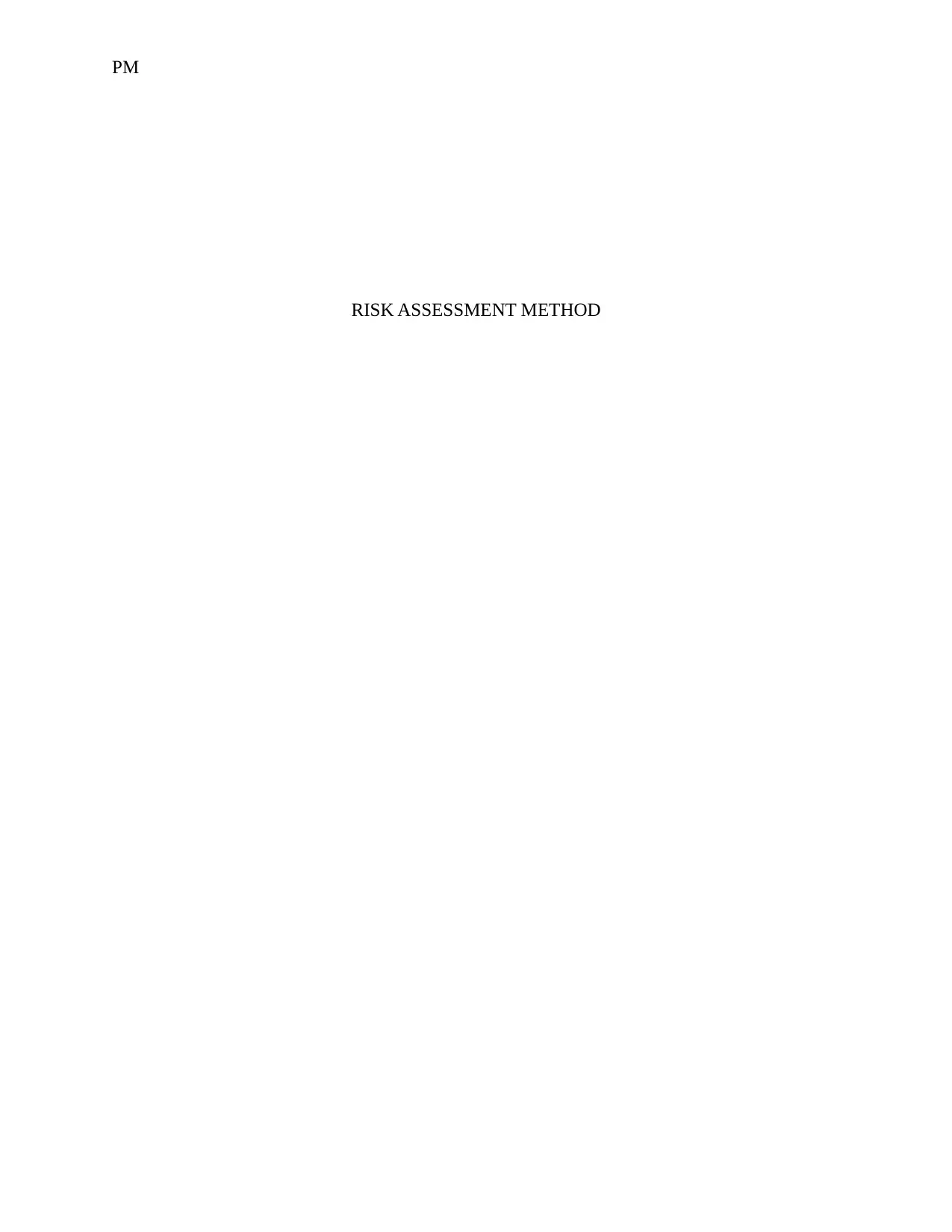
PM
RISK ASSESSMENT METHOD
RISK ASSESSMENT METHOD
Paraphrase This Document
Need a fresh take? Get an instant paraphrase of this document with our AI Paraphraser
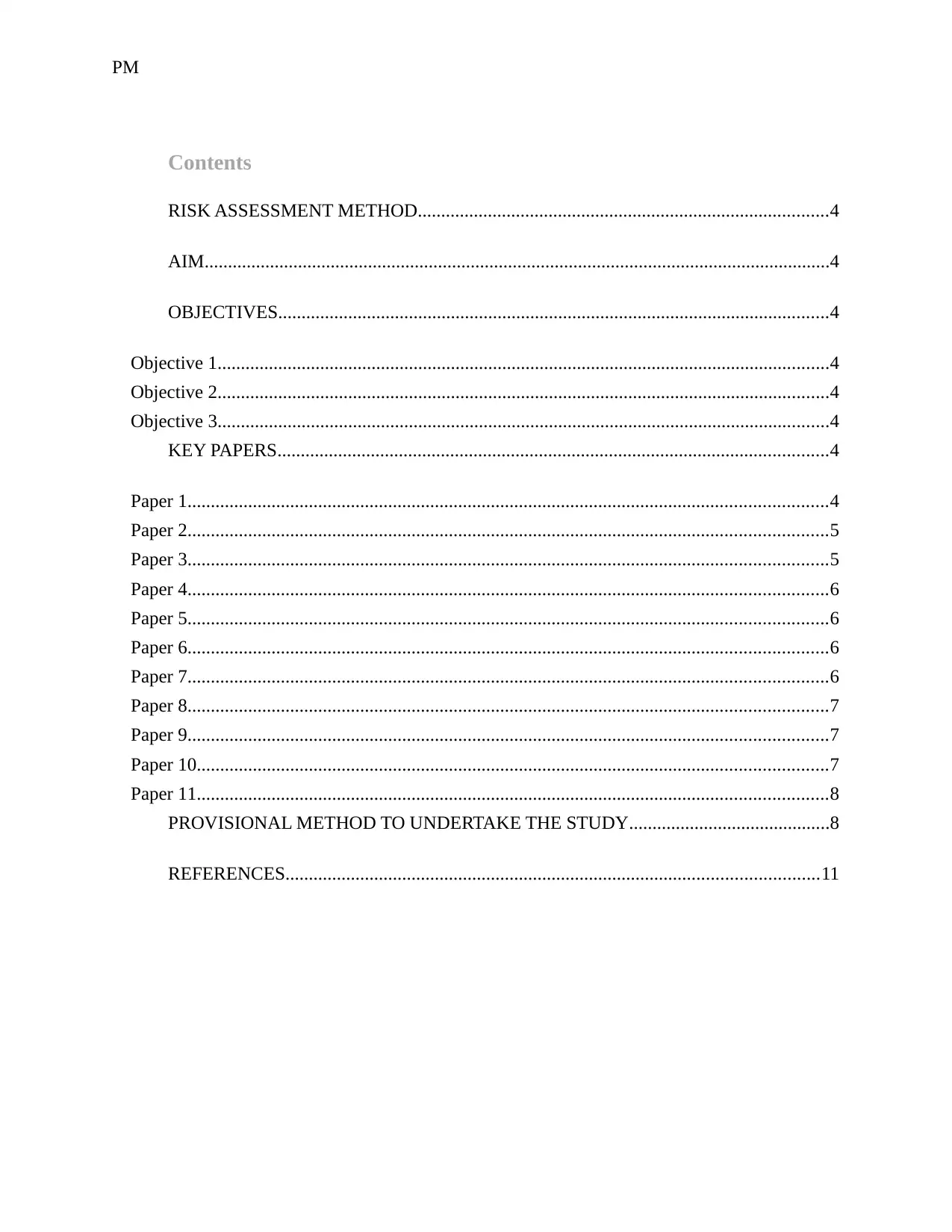
PM
Contents
RISK ASSESSMENT METHOD........................................................................................4
AIM......................................................................................................................................4
OBJECTIVES......................................................................................................................4
Objective 1...................................................................................................................................4
Objective 2...................................................................................................................................4
Objective 3...................................................................................................................................4
KEY PAPERS......................................................................................................................4
Paper 1.........................................................................................................................................4
Paper 2.........................................................................................................................................5
Paper 3.........................................................................................................................................5
Paper 4.........................................................................................................................................6
Paper 5.........................................................................................................................................6
Paper 6.........................................................................................................................................6
Paper 7.........................................................................................................................................6
Paper 8.........................................................................................................................................7
Paper 9.........................................................................................................................................7
Paper 10.......................................................................................................................................7
Paper 11.......................................................................................................................................8
PROVISIONAL METHOD TO UNDERTAKE THE STUDY...........................................8
REFERENCES..................................................................................................................11
Contents
RISK ASSESSMENT METHOD........................................................................................4
AIM......................................................................................................................................4
OBJECTIVES......................................................................................................................4
Objective 1...................................................................................................................................4
Objective 2...................................................................................................................................4
Objective 3...................................................................................................................................4
KEY PAPERS......................................................................................................................4
Paper 1.........................................................................................................................................4
Paper 2.........................................................................................................................................5
Paper 3.........................................................................................................................................5
Paper 4.........................................................................................................................................6
Paper 5.........................................................................................................................................6
Paper 6.........................................................................................................................................6
Paper 7.........................................................................................................................................6
Paper 8.........................................................................................................................................7
Paper 9.........................................................................................................................................7
Paper 10.......................................................................................................................................7
Paper 11.......................................................................................................................................8
PROVISIONAL METHOD TO UNDERTAKE THE STUDY...........................................8
REFERENCES..................................................................................................................11
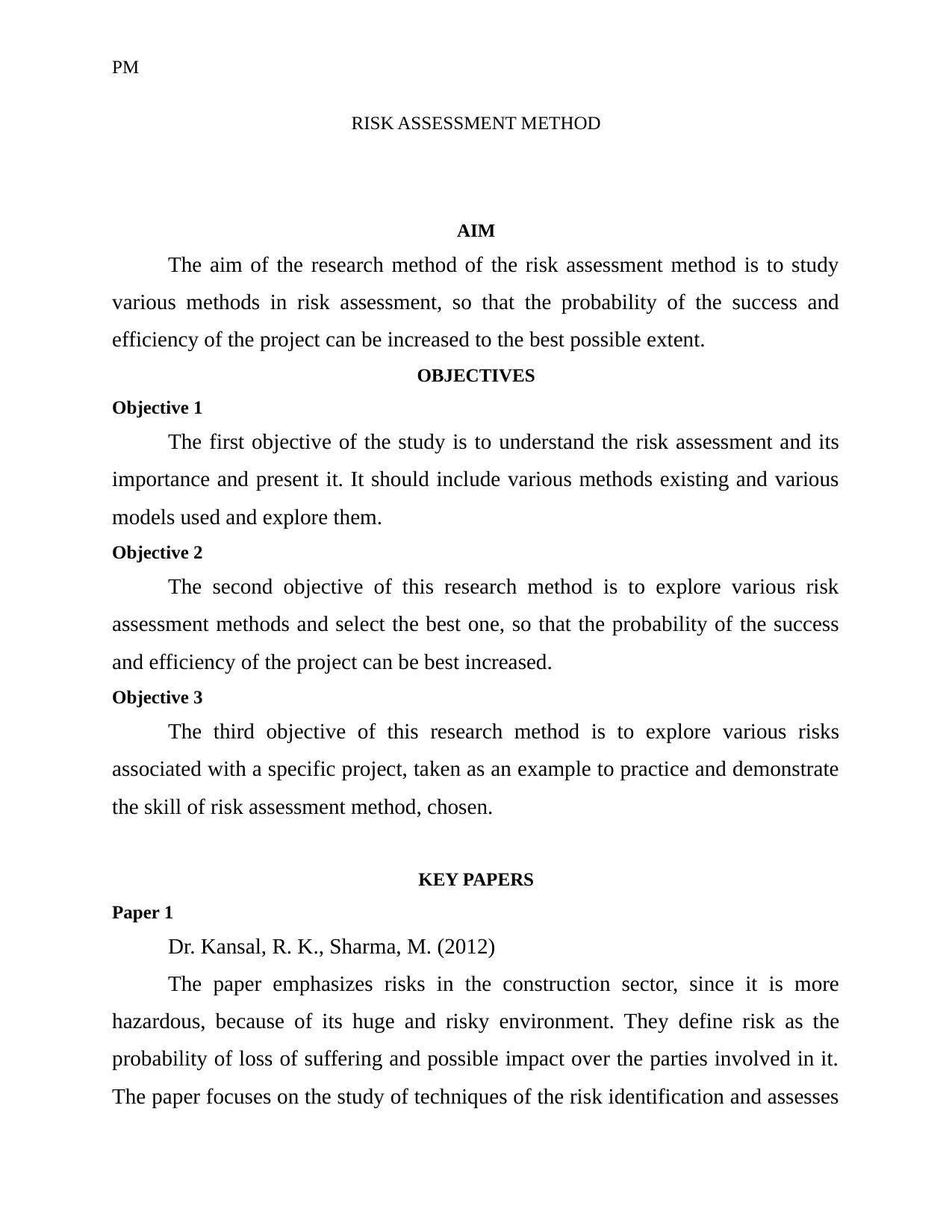
PM
RISK ASSESSMENT METHOD
AIM
The aim of the research method of the risk assessment method is to study
various methods in risk assessment, so that the probability of the success and
efficiency of the project can be increased to the best possible extent.
OBJECTIVES
Objective 1
The first objective of the study is to understand the risk assessment and its
importance and present it. It should include various methods existing and various
models used and explore them.
Objective 2
The second objective of this research method is to explore various risk
assessment methods and select the best one, so that the probability of the success
and efficiency of the project can be best increased.
Objective 3
The third objective of this research method is to explore various risks
associated with a specific project, taken as an example to practice and demonstrate
the skill of risk assessment method, chosen.
KEY PAPERS
Paper 1
Dr. Kansal, R. K., Sharma, M. (2012)
The paper emphasizes risks in the construction sector, since it is more
hazardous, because of its huge and risky environment. They define risk as the
probability of loss of suffering and possible impact over the parties involved in it.
The paper focuses on the study of techniques of the risk identification and assesses
RISK ASSESSMENT METHOD
AIM
The aim of the research method of the risk assessment method is to study
various methods in risk assessment, so that the probability of the success and
efficiency of the project can be increased to the best possible extent.
OBJECTIVES
Objective 1
The first objective of the study is to understand the risk assessment and its
importance and present it. It should include various methods existing and various
models used and explore them.
Objective 2
The second objective of this research method is to explore various risk
assessment methods and select the best one, so that the probability of the success
and efficiency of the project can be best increased.
Objective 3
The third objective of this research method is to explore various risks
associated with a specific project, taken as an example to practice and demonstrate
the skill of risk assessment method, chosen.
KEY PAPERS
Paper 1
Dr. Kansal, R. K., Sharma, M. (2012)
The paper emphasizes risks in the construction sector, since it is more
hazardous, because of its huge and risky environment. They define risk as the
probability of loss of suffering and possible impact over the parties involved in it.
The paper focuses on the study of techniques of the risk identification and assesses
⊘ This is a preview!⊘
Do you want full access?
Subscribe today to unlock all pages.

Trusted by 1+ million students worldwide
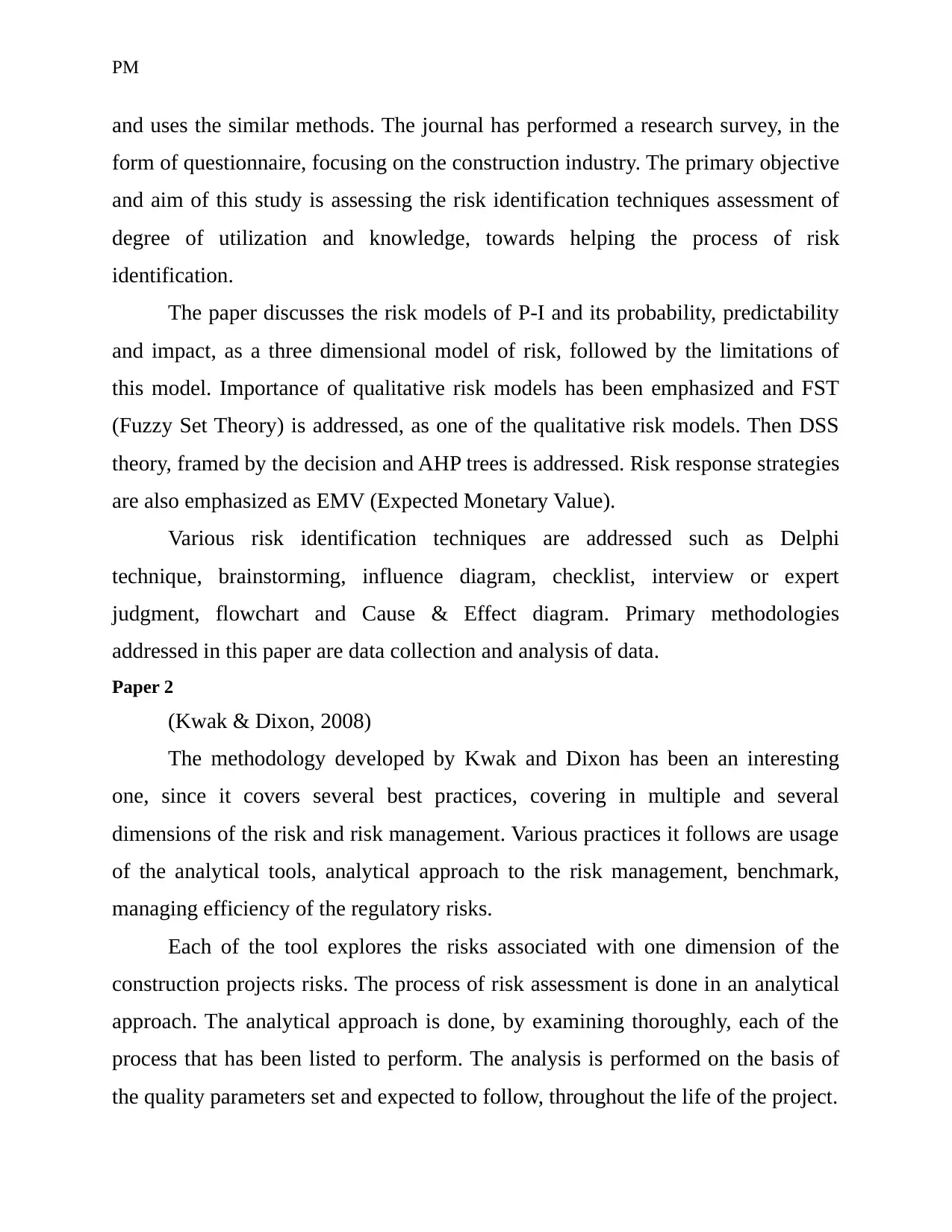
PM
and uses the similar methods. The journal has performed a research survey, in the
form of questionnaire, focusing on the construction industry. The primary objective
and aim of this study is assessing the risk identification techniques assessment of
degree of utilization and knowledge, towards helping the process of risk
identification.
The paper discusses the risk models of P-I and its probability, predictability
and impact, as a three dimensional model of risk, followed by the limitations of
this model. Importance of qualitative risk models has been emphasized and FST
(Fuzzy Set Theory) is addressed, as one of the qualitative risk models. Then DSS
theory, framed by the decision and AHP trees is addressed. Risk response strategies
are also emphasized as EMV (Expected Monetary Value).
Various risk identification techniques are addressed such as Delphi
technique, brainstorming, influence diagram, checklist, interview or expert
judgment, flowchart and Cause & Effect diagram. Primary methodologies
addressed in this paper are data collection and analysis of data.
Paper 2
(Kwak & Dixon, 2008)
The methodology developed by Kwak and Dixon has been an interesting
one, since it covers several best practices, covering in multiple and several
dimensions of the risk and risk management. Various practices it follows are usage
of the analytical tools, analytical approach to the risk management, benchmark,
managing efficiency of the regulatory risks.
Each of the tool explores the risks associated with one dimension of the
construction projects risks. The process of risk assessment is done in an analytical
approach. The analytical approach is done, by examining thoroughly, each of the
process that has been listed to perform. The analysis is performed on the basis of
the quality parameters set and expected to follow, throughout the life of the project.
and uses the similar methods. The journal has performed a research survey, in the
form of questionnaire, focusing on the construction industry. The primary objective
and aim of this study is assessing the risk identification techniques assessment of
degree of utilization and knowledge, towards helping the process of risk
identification.
The paper discusses the risk models of P-I and its probability, predictability
and impact, as a three dimensional model of risk, followed by the limitations of
this model. Importance of qualitative risk models has been emphasized and FST
(Fuzzy Set Theory) is addressed, as one of the qualitative risk models. Then DSS
theory, framed by the decision and AHP trees is addressed. Risk response strategies
are also emphasized as EMV (Expected Monetary Value).
Various risk identification techniques are addressed such as Delphi
technique, brainstorming, influence diagram, checklist, interview or expert
judgment, flowchart and Cause & Effect diagram. Primary methodologies
addressed in this paper are data collection and analysis of data.
Paper 2
(Kwak & Dixon, 2008)
The methodology developed by Kwak and Dixon has been an interesting
one, since it covers several best practices, covering in multiple and several
dimensions of the risk and risk management. Various practices it follows are usage
of the analytical tools, analytical approach to the risk management, benchmark,
managing efficiency of the regulatory risks.
Each of the tool explores the risks associated with one dimension of the
construction projects risks. The process of risk assessment is done in an analytical
approach. The analytical approach is done, by examining thoroughly, each of the
process that has been listed to perform. The analysis is performed on the basis of
the quality parameters set and expected to follow, throughout the life of the project.
Paraphrase This Document
Need a fresh take? Get an instant paraphrase of this document with our AI Paraphraser
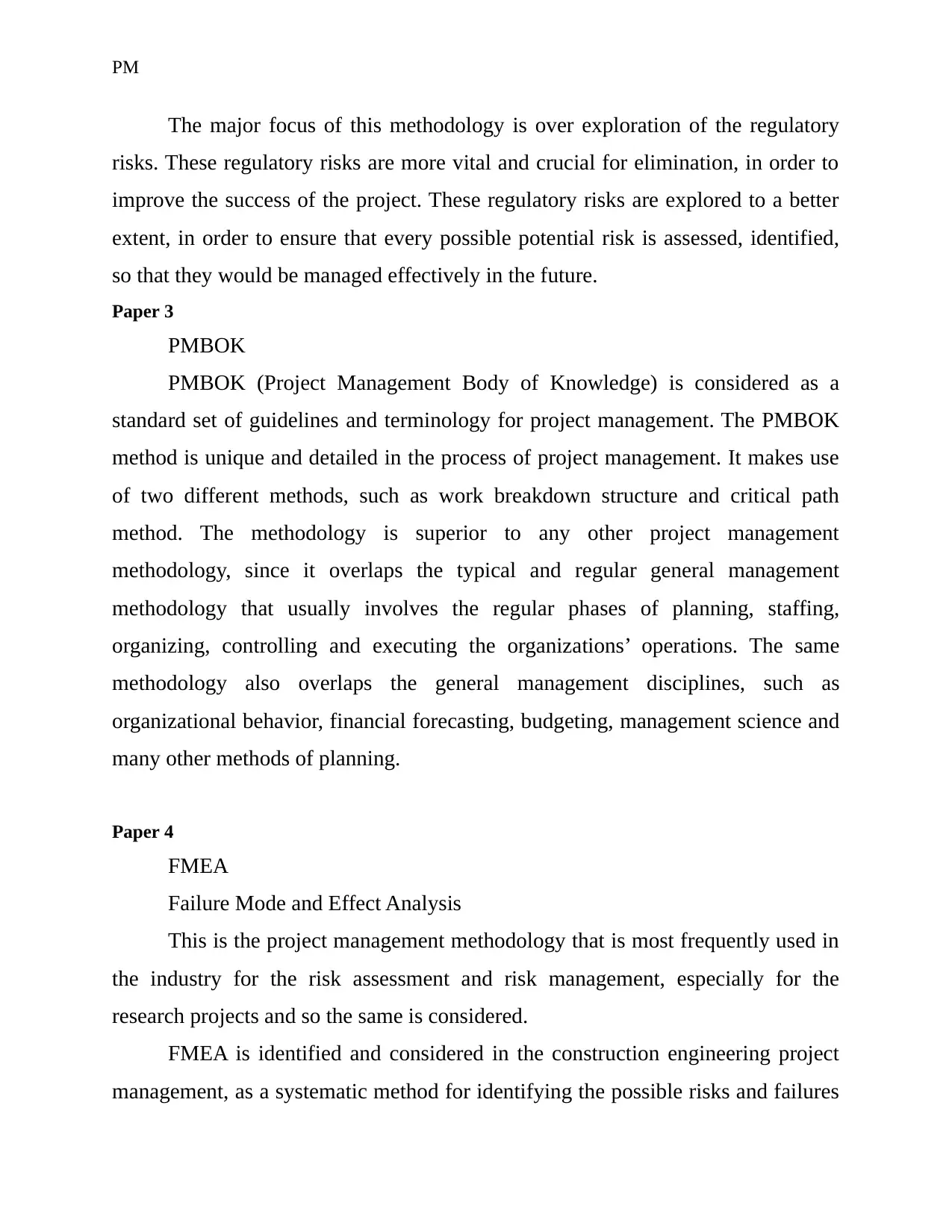
PM
The major focus of this methodology is over exploration of the regulatory
risks. These regulatory risks are more vital and crucial for elimination, in order to
improve the success of the project. These regulatory risks are explored to a better
extent, in order to ensure that every possible potential risk is assessed, identified,
so that they would be managed effectively in the future.
Paper 3
PMBOK
PMBOK (Project Management Body of Knowledge) is considered as a
standard set of guidelines and terminology for project management. The PMBOK
method is unique and detailed in the process of project management. It makes use
of two different methods, such as work breakdown structure and critical path
method. The methodology is superior to any other project management
methodology, since it overlaps the typical and regular general management
methodology that usually involves the regular phases of planning, staffing,
organizing, controlling and executing the organizations’ operations. The same
methodology also overlaps the general management disciplines, such as
organizational behavior, financial forecasting, budgeting, management science and
many other methods of planning.
Paper 4
FMEA
Failure Mode and Effect Analysis
This is the project management methodology that is most frequently used in
the industry for the risk assessment and risk management, especially for the
research projects and so the same is considered.
FMEA is identified and considered in the construction engineering project
management, as a systematic method for identifying the possible risks and failures
The major focus of this methodology is over exploration of the regulatory
risks. These regulatory risks are more vital and crucial for elimination, in order to
improve the success of the project. These regulatory risks are explored to a better
extent, in order to ensure that every possible potential risk is assessed, identified,
so that they would be managed effectively in the future.
Paper 3
PMBOK
PMBOK (Project Management Body of Knowledge) is considered as a
standard set of guidelines and terminology for project management. The PMBOK
method is unique and detailed in the process of project management. It makes use
of two different methods, such as work breakdown structure and critical path
method. The methodology is superior to any other project management
methodology, since it overlaps the typical and regular general management
methodology that usually involves the regular phases of planning, staffing,
organizing, controlling and executing the organizations’ operations. The same
methodology also overlaps the general management disciplines, such as
organizational behavior, financial forecasting, budgeting, management science and
many other methods of planning.
Paper 4
FMEA
Failure Mode and Effect Analysis
This is the project management methodology that is most frequently used in
the industry for the risk assessment and risk management, especially for the
research projects and so the same is considered.
FMEA is identified and considered in the construction engineering project
management, as a systematic method for identifying the possible risks and failures
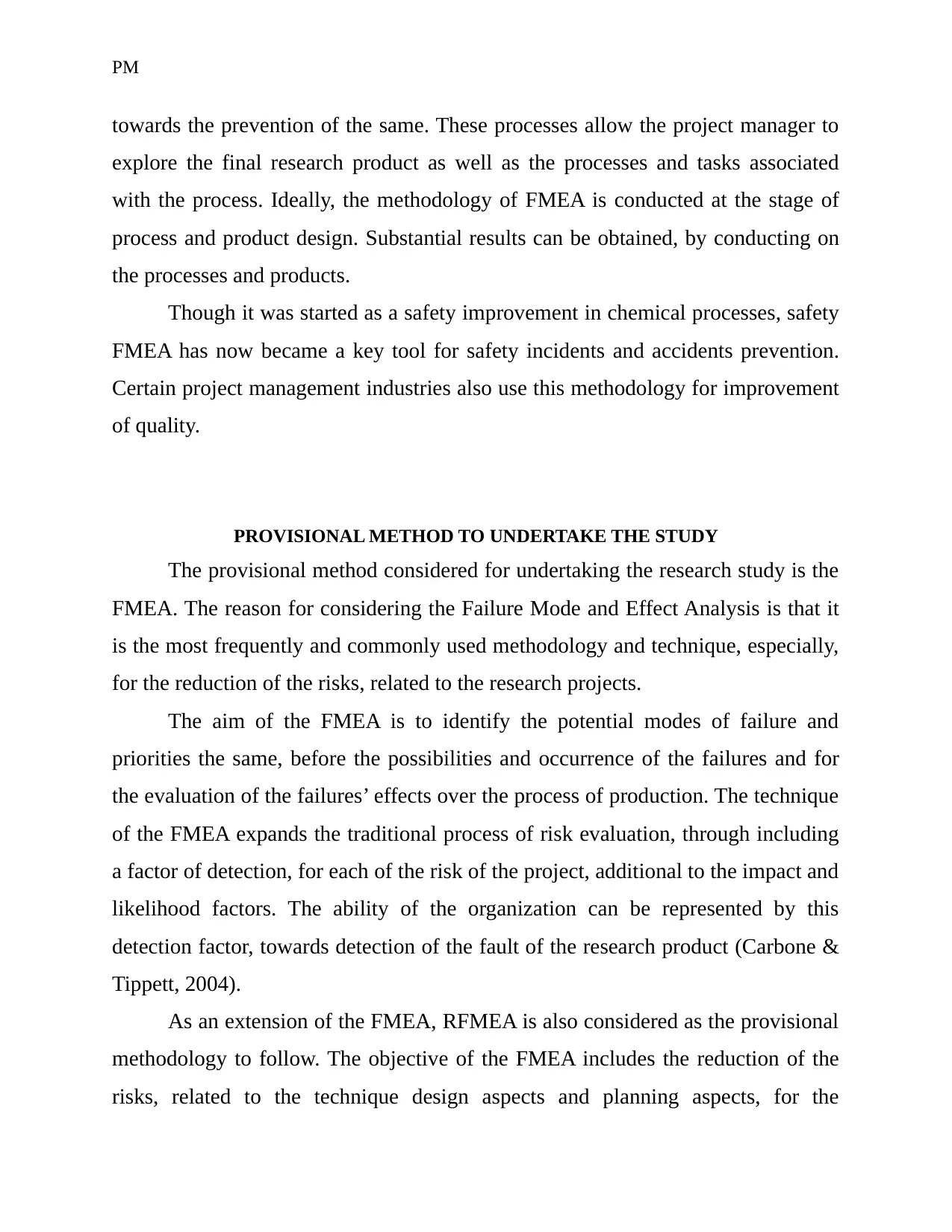
PM
towards the prevention of the same. These processes allow the project manager to
explore the final research product as well as the processes and tasks associated
with the process. Ideally, the methodology of FMEA is conducted at the stage of
process and product design. Substantial results can be obtained, by conducting on
the processes and products.
Though it was started as a safety improvement in chemical processes, safety
FMEA has now became a key tool for safety incidents and accidents prevention.
Certain project management industries also use this methodology for improvement
of quality.
PROVISIONAL METHOD TO UNDERTAKE THE STUDY
The provisional method considered for undertaking the research study is the
FMEA. The reason for considering the Failure Mode and Effect Analysis is that it
is the most frequently and commonly used methodology and technique, especially,
for the reduction of the risks, related to the research projects.
The aim of the FMEA is to identify the potential modes of failure and
priorities the same, before the possibilities and occurrence of the failures and for
the evaluation of the failures’ effects over the process of production. The technique
of the FMEA expands the traditional process of risk evaluation, through including
a factor of detection, for each of the risk of the project, additional to the impact and
likelihood factors. The ability of the organization can be represented by this
detection factor, towards detection of the fault of the research product (Carbone &
Tippett, 2004).
As an extension of the FMEA, RFMEA is also considered as the provisional
methodology to follow. The objective of the FMEA includes the reduction of the
risks, related to the technique design aspects and planning aspects, for the
towards the prevention of the same. These processes allow the project manager to
explore the final research product as well as the processes and tasks associated
with the process. Ideally, the methodology of FMEA is conducted at the stage of
process and product design. Substantial results can be obtained, by conducting on
the processes and products.
Though it was started as a safety improvement in chemical processes, safety
FMEA has now became a key tool for safety incidents and accidents prevention.
Certain project management industries also use this methodology for improvement
of quality.
PROVISIONAL METHOD TO UNDERTAKE THE STUDY
The provisional method considered for undertaking the research study is the
FMEA. The reason for considering the Failure Mode and Effect Analysis is that it
is the most frequently and commonly used methodology and technique, especially,
for the reduction of the risks, related to the research projects.
The aim of the FMEA is to identify the potential modes of failure and
priorities the same, before the possibilities and occurrence of the failures and for
the evaluation of the failures’ effects over the process of production. The technique
of the FMEA expands the traditional process of risk evaluation, through including
a factor of detection, for each of the risk of the project, additional to the impact and
likelihood factors. The ability of the organization can be represented by this
detection factor, towards detection of the fault of the research product (Carbone &
Tippett, 2004).
As an extension of the FMEA, RFMEA is also considered as the provisional
methodology to follow. The objective of the FMEA includes the reduction of the
risks, related to the technique design aspects and planning aspects, for the
⊘ This is a preview!⊘
Do you want full access?
Subscribe today to unlock all pages.

Trusted by 1+ million students worldwide
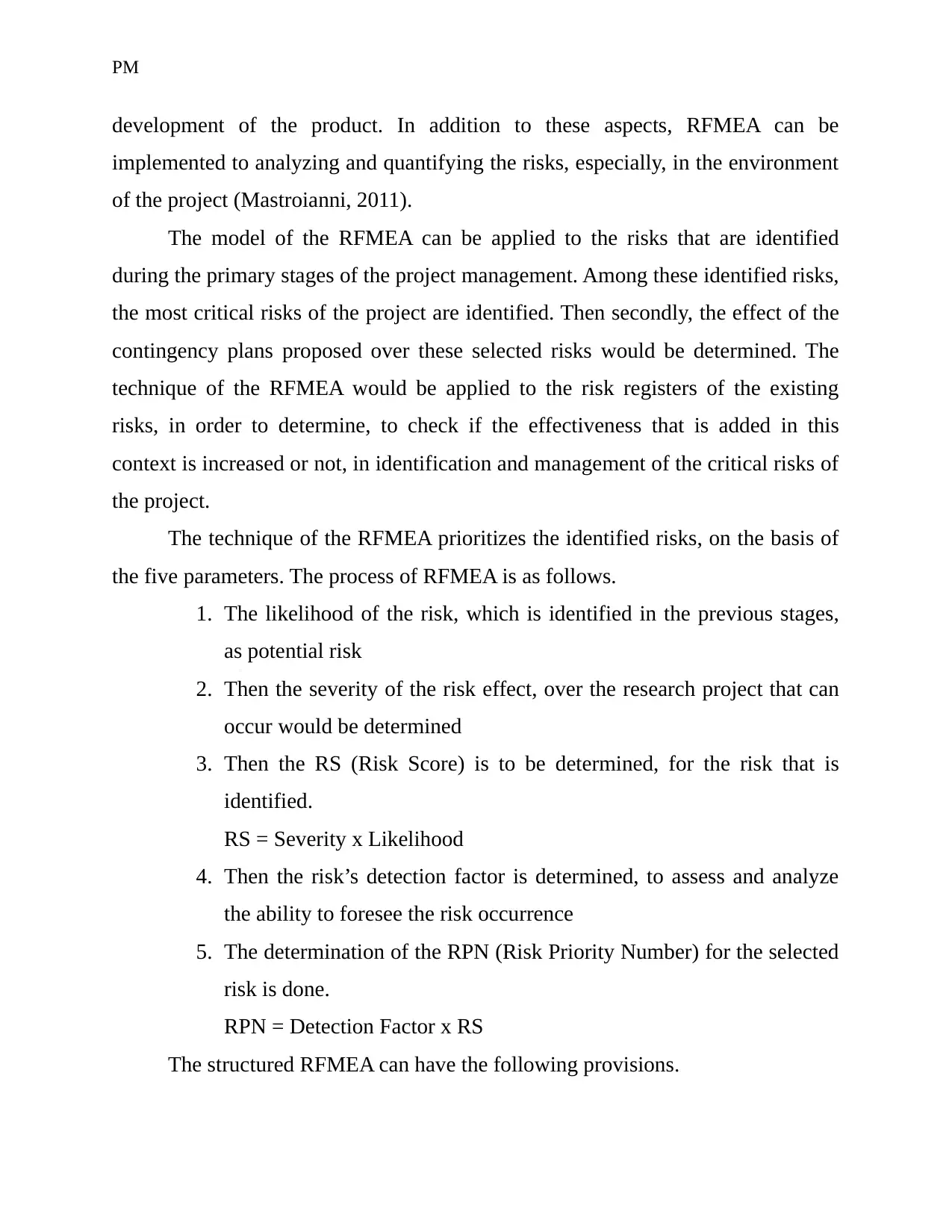
PM
development of the product. In addition to these aspects, RFMEA can be
implemented to analyzing and quantifying the risks, especially, in the environment
of the project (Mastroianni, 2011).
The model of the RFMEA can be applied to the risks that are identified
during the primary stages of the project management. Among these identified risks,
the most critical risks of the project are identified. Then secondly, the effect of the
contingency plans proposed over these selected risks would be determined. The
technique of the RFMEA would be applied to the risk registers of the existing
risks, in order to determine, to check if the effectiveness that is added in this
context is increased or not, in identification and management of the critical risks of
the project.
The technique of the RFMEA prioritizes the identified risks, on the basis of
the five parameters. The process of RFMEA is as follows.
1. The likelihood of the risk, which is identified in the previous stages,
as potential risk
2. Then the severity of the risk effect, over the research project that can
occur would be determined
3. Then the RS (Risk Score) is to be determined, for the risk that is
identified.
RS = Severity x Likelihood
4. Then the risk’s detection factor is determined, to assess and analyze
the ability to foresee the risk occurrence
5. The determination of the RPN (Risk Priority Number) for the selected
risk is done.
RPN = Detection Factor x RS
The structured RFMEA can have the following provisions.
development of the product. In addition to these aspects, RFMEA can be
implemented to analyzing and quantifying the risks, especially, in the environment
of the project (Mastroianni, 2011).
The model of the RFMEA can be applied to the risks that are identified
during the primary stages of the project management. Among these identified risks,
the most critical risks of the project are identified. Then secondly, the effect of the
contingency plans proposed over these selected risks would be determined. The
technique of the RFMEA would be applied to the risk registers of the existing
risks, in order to determine, to check if the effectiveness that is added in this
context is increased or not, in identification and management of the critical risks of
the project.
The technique of the RFMEA prioritizes the identified risks, on the basis of
the five parameters. The process of RFMEA is as follows.
1. The likelihood of the risk, which is identified in the previous stages,
as potential risk
2. Then the severity of the risk effect, over the research project that can
occur would be determined
3. Then the RS (Risk Score) is to be determined, for the risk that is
identified.
RS = Severity x Likelihood
4. Then the risk’s detection factor is determined, to assess and analyze
the ability to foresee the risk occurrence
5. The determination of the RPN (Risk Priority Number) for the selected
risk is done.
RPN = Detection Factor x RS
The structured RFMEA can have the following provisions.
Paraphrase This Document
Need a fresh take? Get an instant paraphrase of this document with our AI Paraphraser
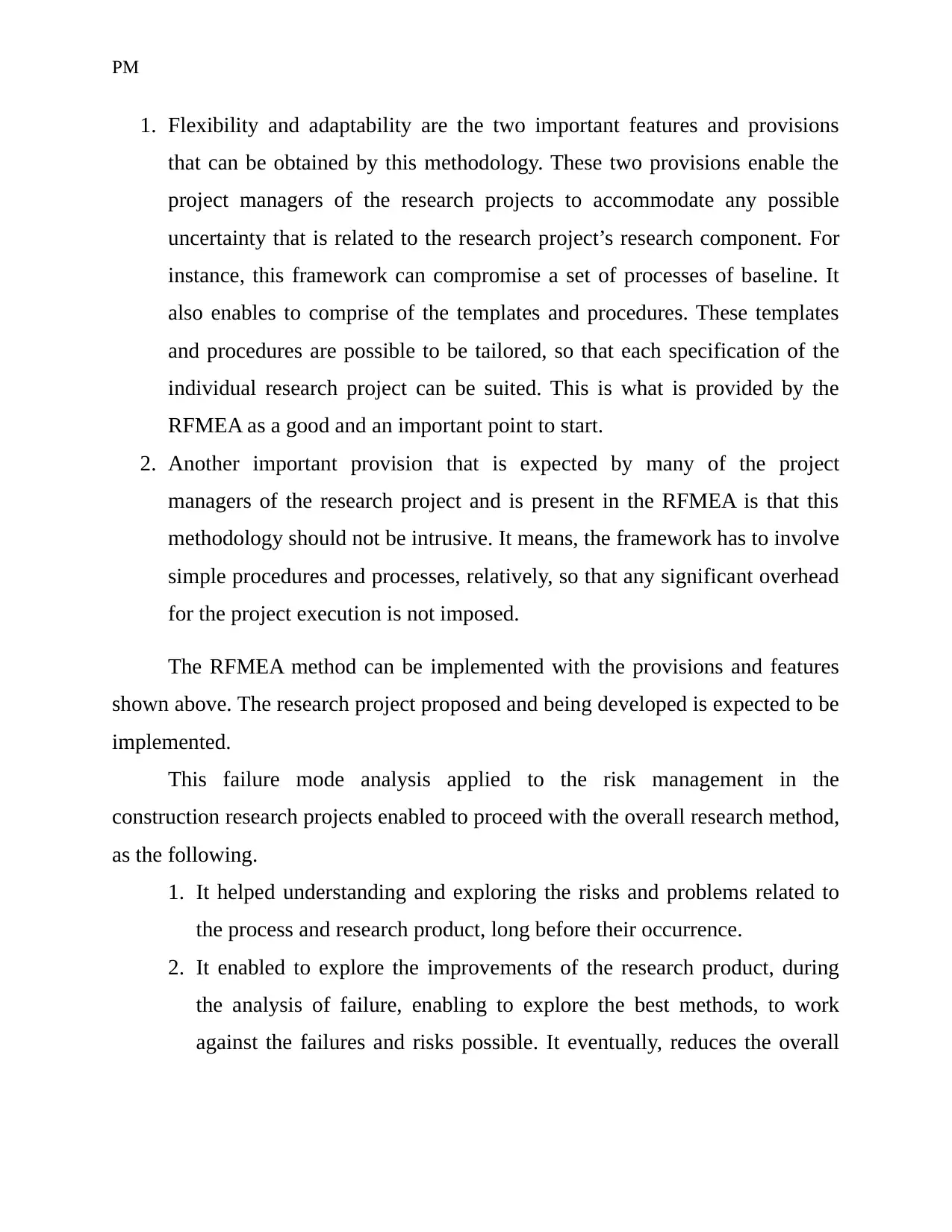
PM
1. Flexibility and adaptability are the two important features and provisions
that can be obtained by this methodology. These two provisions enable the
project managers of the research projects to accommodate any possible
uncertainty that is related to the research project’s research component. For
instance, this framework can compromise a set of processes of baseline. It
also enables to comprise of the templates and procedures. These templates
and procedures are possible to be tailored, so that each specification of the
individual research project can be suited. This is what is provided by the
RFMEA as a good and an important point to start.
2. Another important provision that is expected by many of the project
managers of the research project and is present in the RFMEA is that this
methodology should not be intrusive. It means, the framework has to involve
simple procedures and processes, relatively, so that any significant overhead
for the project execution is not imposed.
The RFMEA method can be implemented with the provisions and features
shown above. The research project proposed and being developed is expected to be
implemented.
This failure mode analysis applied to the risk management in the
construction research projects enabled to proceed with the overall research method,
as the following.
1. It helped understanding and exploring the risks and problems related to
the process and research product, long before their occurrence.
2. It enabled to explore the improvements of the research product, during
the analysis of failure, enabling to explore the best methods, to work
against the failures and risks possible. It eventually, reduces the overall
1. Flexibility and adaptability are the two important features and provisions
that can be obtained by this methodology. These two provisions enable the
project managers of the research projects to accommodate any possible
uncertainty that is related to the research project’s research component. For
instance, this framework can compromise a set of processes of baseline. It
also enables to comprise of the templates and procedures. These templates
and procedures are possible to be tailored, so that each specification of the
individual research project can be suited. This is what is provided by the
RFMEA as a good and an important point to start.
2. Another important provision that is expected by many of the project
managers of the research project and is present in the RFMEA is that this
methodology should not be intrusive. It means, the framework has to involve
simple procedures and processes, relatively, so that any significant overhead
for the project execution is not imposed.
The RFMEA method can be implemented with the provisions and features
shown above. The research project proposed and being developed is expected to be
implemented.
This failure mode analysis applied to the risk management in the
construction research projects enabled to proceed with the overall research method,
as the following.
1. It helped understanding and exploring the risks and problems related to
the process and research product, long before their occurrence.
2. It enabled to explore the improvements of the research product, during
the analysis of failure, enabling to explore the best methods, to work
against the failures and risks possible. It eventually, reduces the overall
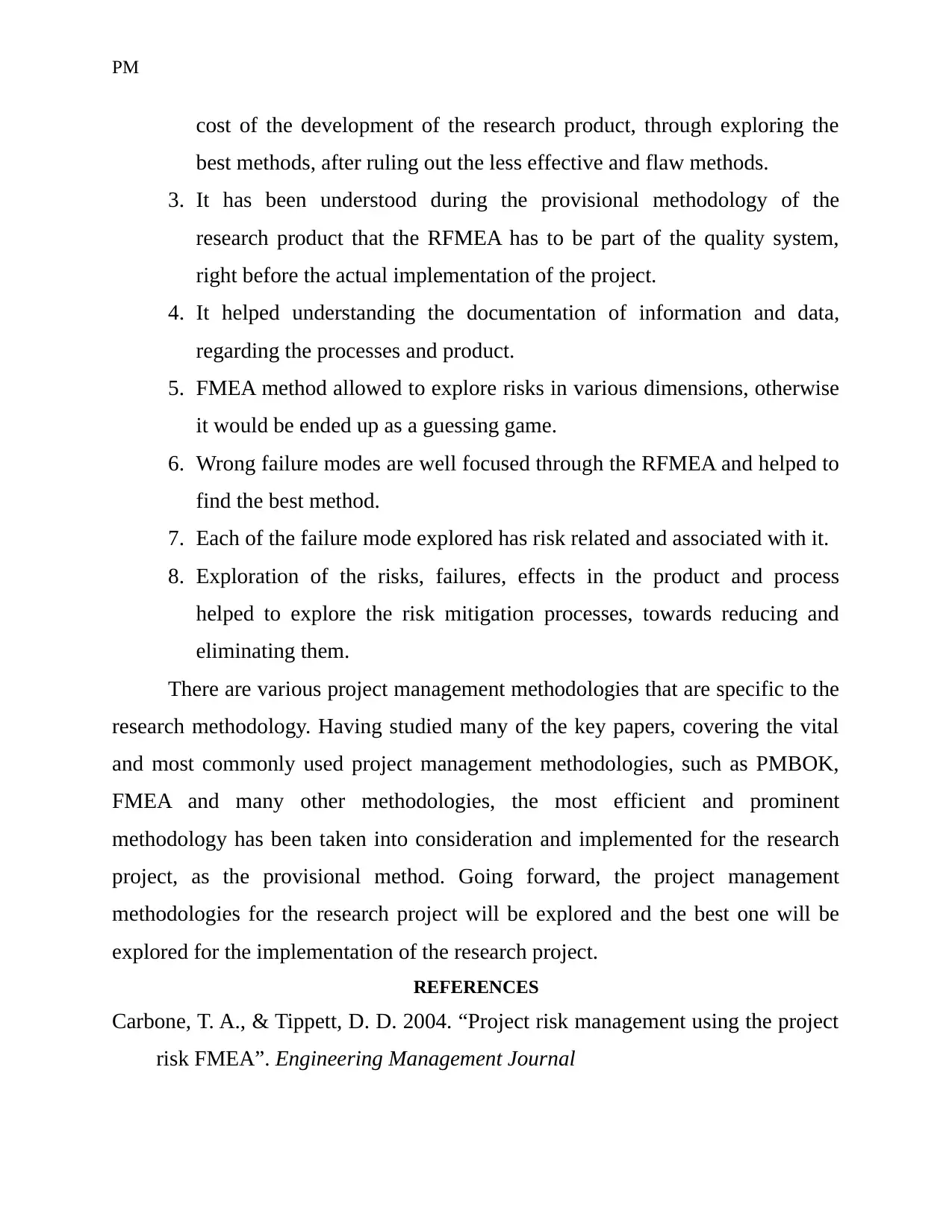
PM
cost of the development of the research product, through exploring the
best methods, after ruling out the less effective and flaw methods.
3. It has been understood during the provisional methodology of the
research product that the RFMEA has to be part of the quality system,
right before the actual implementation of the project.
4. It helped understanding the documentation of information and data,
regarding the processes and product.
5. FMEA method allowed to explore risks in various dimensions, otherwise
it would be ended up as a guessing game.
6. Wrong failure modes are well focused through the RFMEA and helped to
find the best method.
7. Each of the failure mode explored has risk related and associated with it.
8. Exploration of the risks, failures, effects in the product and process
helped to explore the risk mitigation processes, towards reducing and
eliminating them.
There are various project management methodologies that are specific to the
research methodology. Having studied many of the key papers, covering the vital
and most commonly used project management methodologies, such as PMBOK,
FMEA and many other methodologies, the most efficient and prominent
methodology has been taken into consideration and implemented for the research
project, as the provisional method. Going forward, the project management
methodologies for the research project will be explored and the best one will be
explored for the implementation of the research project.
REFERENCES
Carbone, T. A., & Tippett, D. D. 2004. “Project risk management using the project
risk FMEA”. Engineering Management Journal
cost of the development of the research product, through exploring the
best methods, after ruling out the less effective and flaw methods.
3. It has been understood during the provisional methodology of the
research product that the RFMEA has to be part of the quality system,
right before the actual implementation of the project.
4. It helped understanding the documentation of information and data,
regarding the processes and product.
5. FMEA method allowed to explore risks in various dimensions, otherwise
it would be ended up as a guessing game.
6. Wrong failure modes are well focused through the RFMEA and helped to
find the best method.
7. Each of the failure mode explored has risk related and associated with it.
8. Exploration of the risks, failures, effects in the product and process
helped to explore the risk mitigation processes, towards reducing and
eliminating them.
There are various project management methodologies that are specific to the
research methodology. Having studied many of the key papers, covering the vital
and most commonly used project management methodologies, such as PMBOK,
FMEA and many other methodologies, the most efficient and prominent
methodology has been taken into consideration and implemented for the research
project, as the provisional method. Going forward, the project management
methodologies for the research project will be explored and the best one will be
explored for the implementation of the research project.
REFERENCES
Carbone, T. A., & Tippett, D. D. 2004. “Project risk management using the project
risk FMEA”. Engineering Management Journal
⊘ This is a preview!⊘
Do you want full access?
Subscribe today to unlock all pages.

Trusted by 1+ million students worldwide
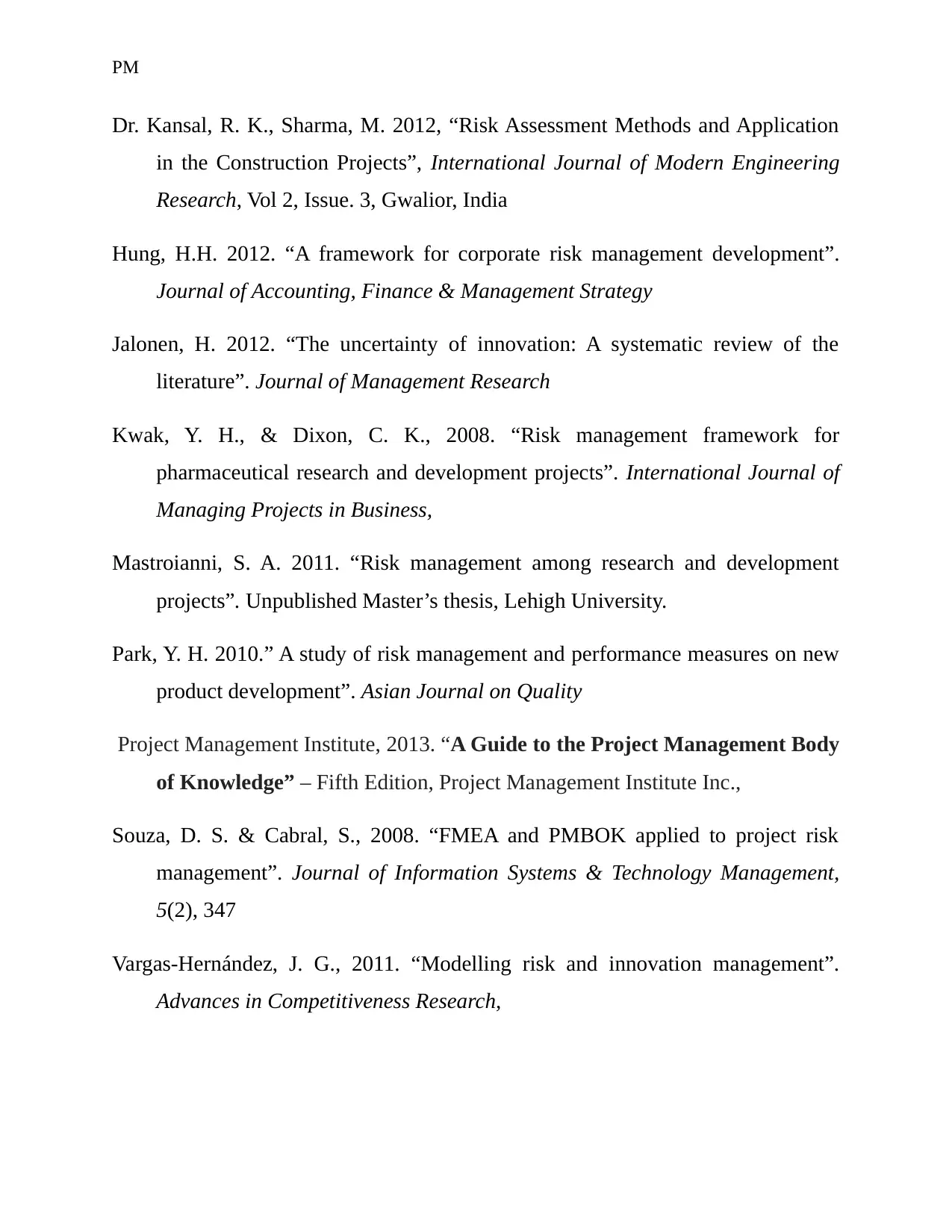
PM
Dr. Kansal, R. K., Sharma, M. 2012, “Risk Assessment Methods and Application
in the Construction Projects”, International Journal of Modern Engineering
Research, Vol 2, Issue. 3, Gwalior, India
Hung, H.H. 2012. “A framework for corporate risk management development”.
Journal of Accounting, Finance & Management Strategy
Jalonen, H. 2012. “The uncertainty of innovation: A systematic review of the
literature”. Journal of Management Research
Kwak, Y. H., & Dixon, C. K., 2008. “Risk management framework for
pharmaceutical research and development projects”. International Journal of
Managing Projects in Business,
Mastroianni, S. A. 2011. “Risk management among research and development
projects”. Unpublished Master’s thesis, Lehigh University.
Park, Y. H. 2010.” A study of risk management and performance measures on new
product development”. Asian Journal on Quality
Project Management Institute, 2013. “A Guide to the Project Management Body
of Knowledge” – Fifth Edition, Project Management Institute Inc.,
Souza, D. S. & Cabral, S., 2008. “FMEA and PMBOK applied to project risk
management”. Journal of Information Systems & Technology Management,
5(2), 347
Vargas-Hernández, J. G., 2011. “Modelling risk and innovation management”.
Advances in Competitiveness Research,
Dr. Kansal, R. K., Sharma, M. 2012, “Risk Assessment Methods and Application
in the Construction Projects”, International Journal of Modern Engineering
Research, Vol 2, Issue. 3, Gwalior, India
Hung, H.H. 2012. “A framework for corporate risk management development”.
Journal of Accounting, Finance & Management Strategy
Jalonen, H. 2012. “The uncertainty of innovation: A systematic review of the
literature”. Journal of Management Research
Kwak, Y. H., & Dixon, C. K., 2008. “Risk management framework for
pharmaceutical research and development projects”. International Journal of
Managing Projects in Business,
Mastroianni, S. A. 2011. “Risk management among research and development
projects”. Unpublished Master’s thesis, Lehigh University.
Park, Y. H. 2010.” A study of risk management and performance measures on new
product development”. Asian Journal on Quality
Project Management Institute, 2013. “A Guide to the Project Management Body
of Knowledge” – Fifth Edition, Project Management Institute Inc.,
Souza, D. S. & Cabral, S., 2008. “FMEA and PMBOK applied to project risk
management”. Journal of Information Systems & Technology Management,
5(2), 347
Vargas-Hernández, J. G., 2011. “Modelling risk and innovation management”.
Advances in Competitiveness Research,
Paraphrase This Document
Need a fresh take? Get an instant paraphrase of this document with our AI Paraphraser
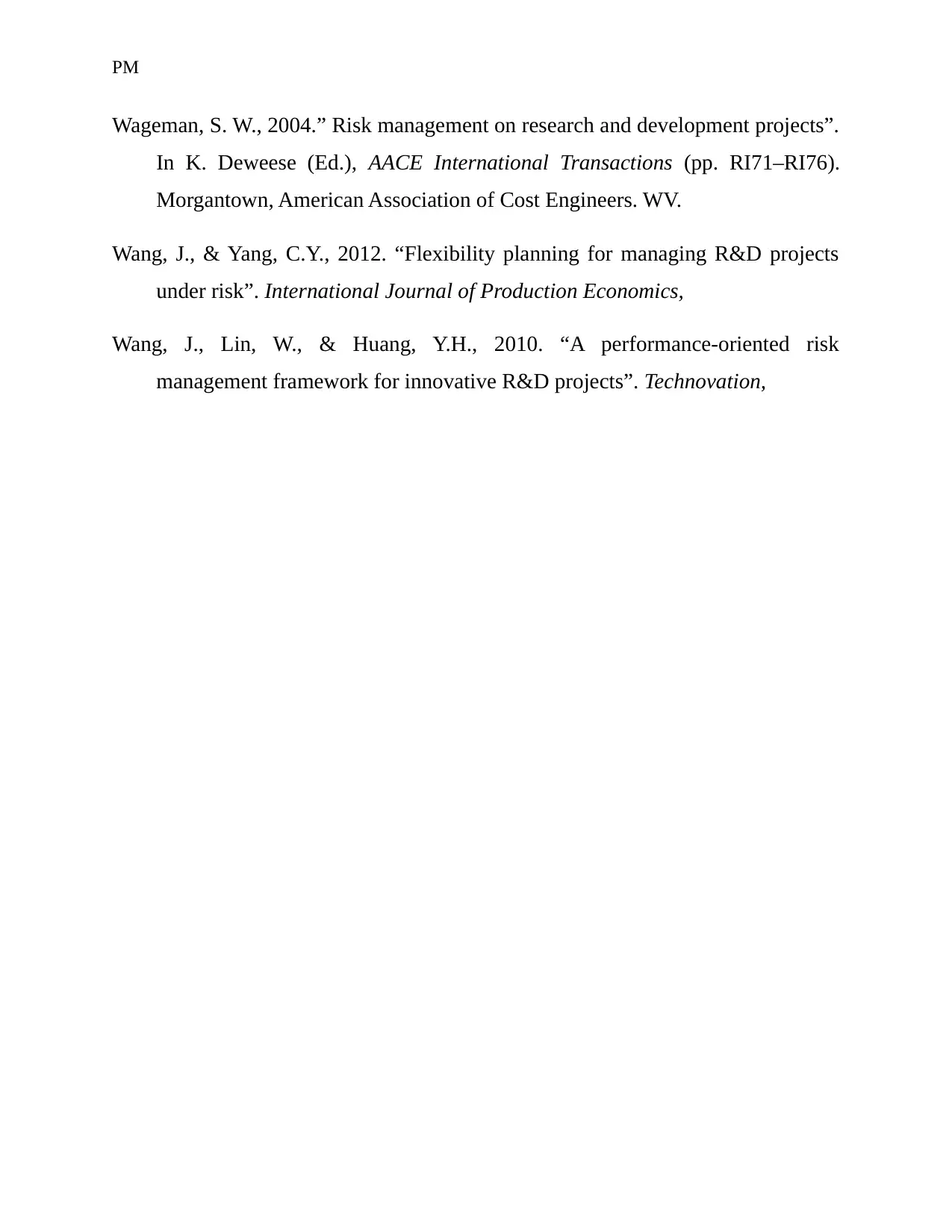
PM
Wageman, S. W., 2004.” Risk management on research and development projects”.
In K. Deweese (Ed.), AACE International Transactions (pp. RI71–RI76).
Morgantown, American Association of Cost Engineers. WV.
Wang, J., & Yang, C.Y., 2012. “Flexibility planning for managing R&D projects
under risk”. International Journal of Production Economics,
Wang, J., Lin, W., & Huang, Y.H., 2010. “A performance-oriented risk
management framework for innovative R&D projects”. Technovation,
Wageman, S. W., 2004.” Risk management on research and development projects”.
In K. Deweese (Ed.), AACE International Transactions (pp. RI71–RI76).
Morgantown, American Association of Cost Engineers. WV.
Wang, J., & Yang, C.Y., 2012. “Flexibility planning for managing R&D projects
under risk”. International Journal of Production Economics,
Wang, J., Lin, W., & Huang, Y.H., 2010. “A performance-oriented risk
management framework for innovative R&D projects”. Technovation,
1 out of 11
Related Documents
Your All-in-One AI-Powered Toolkit for Academic Success.
+13062052269
info@desklib.com
Available 24*7 on WhatsApp / Email
![[object Object]](/_next/static/media/star-bottom.7253800d.svg)
Unlock your academic potential
Copyright © 2020–2025 A2Z Services. All Rights Reserved. Developed and managed by ZUCOL.





